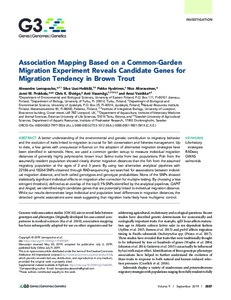| dc.contributor.author | Elvidge CK | |
| dc.contributor.author | Prokkola JM | |
| dc.contributor.author | Lemopoulos A | |
| dc.contributor.author | Alioravainen N | |
| dc.contributor.author | Hyvärinen P | |
| dc.contributor.author | Vasemägi A | |
| dc.contributor.author | Uusi-Heikkilä S | |
| dc.contributor.author | Vainikka A | |
| dc.date.accessioned | 2022-10-28T13:41:39Z | |
| dc.date.available | 2022-10-28T13:41:39Z | |
| dc.identifier.uri | https://www.utupub.fi/handle/10024/166767 | |
| dc.description.abstract | A better understanding of the environmental and genetic contribution to migratory behavior and the evolution of traits linked to migration is crucial for fish conservation and fisheries management. Up to date, a few genes with unequivocal influence on the adoption of alternative migration strategies have been identified in salmonids. Here, we used a common garden set-up to measure individual migration distances of generally highly polymorphic brown trout Salmo trutta from two populations. Fish from the assumedly resident population showed clearly shorter migration distances than the fish from the assumed migratory population at the ages of 2 and 3 years. By using two alternative analytical pipelines with 22186 and 18264 SNPs obtained through RAD-sequencing, we searched for associations between individual migration distance, and both called genotypes and genotype probabilities. None of the SNPs showed statistically significant individual effects on migration after correction for multiple testing. By choosing a less stringent threshold, defined as an overlap of the top 0.1% SNPs identified by the analytical pipelines, GAPIT and Angsd, we identified eight candidate genes that are potentially linked to individual migration distance. While our results demonstrate large individual and population level differences in migration distances, the detected genetic associations were weak suggesting that migration traits likely have multigenic control. | |
| dc.language.iso | en | |
| dc.publisher | GENETICS SOCIETY AMERICA | |
| dc.title | Association Mapping Based on a Common-Garden Migration Experiment Reveals Candidate Genes for Migration Tendency in Brown Trout | |
| dc.identifier.urn | URN:NBN:fi-fe2021042822972 | |
| dc.relation.volume | 9 | |
| dc.contributor.organization | fi=fysiologia ja genetiikka|en=Physiology and Genetics| | |
| dc.contributor.organization | fi=ekologia ja evoluutiobiologia|en=Ecology and Evolutionary Biology| | |
| dc.contributor.organization-code | 2606404 | |
| dc.contributor.organization-code | 2606402 | |
| dc.converis.publication-id | 42718099 | |
| dc.converis.url | https://research.utu.fi/converis/portal/Publication/42718099 | |
| dc.format.pagerange | 2896 | |
| dc.format.pagerange | 2887 | |
| dc.identifier.eissn | 2160-1836 | |
| dc.identifier.jour-issn | 2160-1836 | |
| dc.okm.affiliatedauthor | Vasemägi, Anti | |
| dc.okm.affiliatedauthor | Lemopoulos, Alexandre | |
| dc.okm.affiliatedauthor | Uusi-Heikkilä, Silva | |
| dc.okm.discipline | 1184 Genetics, developmental biology, physiology | en_GB |
| dc.okm.discipline | 1184 Genetiikka, kehitysbiologia, fysiologia | fi_FI |
| dc.okm.internationalcopublication | international co-publication | |
| dc.okm.internationality | International publication | |
| dc.okm.type | Journal article | |
| dc.publisher.country | Yhdysvallat (USA) | fi_FI |
| dc.publisher.country | United States | en_GB |
| dc.publisher.country-code | US | |
| dc.relation.doi | 10.1534/g3.119.400369 | |
| dc.relation.ispartofjournal | G3: genes, genomes, genetics | |
| dc.relation.issue | 9 | |
| dc.year.issued | 2019 | |
